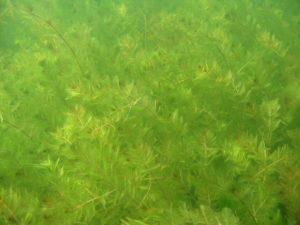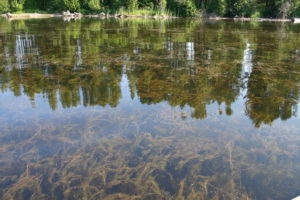Eurasian Watermilfoil (EWM) is an aquatic invasive plant that has invaded lakes across the United States. It is native to Europe and Asia and has been known to be in the U.S. since the 1940’s.
EWM readily invades lake areas with few plants and will out compete native plants as well. It does this by growing rapidly in the spring (often before ice out) and shading out native species. It will eventually grow in thick stands to the water’s surface. Fishing, boating, and other recreational use of these areas is severely curtailed or eliminated altogether.
The most common way that EWM is introduced to a lake is believed to be by hitchhiking on boats and trailers that were used at a lake infested with EWM. Small EWM fragments that are introduced will eventually sink to the bottom and start a new vigorous plant. Additional plants develop from stems extending out from existing plants or from fragments that float to new location and take root. These are created primarily by a natural “autoframentation” process and by wave action or recreational activity.
Efforts to control EWM have shown that it is unlikely to be eliminated once introduced. Rather, control requires ongoing and effective management to minimize EWM density and allow littoral areas to be used recreationally. Control measures have included hand removal, mechanical harvesting, biological control, and use of herbicides. Hand removal techniques are practical when new, small infestations are discovered. Mechanical harvesting is needed for larger areas. It is often used to create navigation lanes through the shallower lake areas to deeper waters. Hand removal and mechanical harvesting have the potential to exacerbate EWM spread because the harvesting activity produces plant fragmentation and many fragments escape detention and removal.
A number of organisms have been tested as vectors for biological control. Most notable has been the “Milfoil” weevil. A commercial operation using this weevil collapsed due to inconsistent results and the high cost to introduce enough weevils to obtain significant control. Use of triploid grass carp that eat plants has been ineffective because they typically eat desired native plants first before dining on the seemingly less tasty EWM later.
Herbicides have been used most frequently due to their effectiveness and relative cost. For small areas, area treatments with systemic or contact herbicides are effective. When EWM is more widespread (upwards of 10% or more of the littoral area), whole lake treatments have better results and are more cost effective. Indian Lake had a whole lake treatment with Sonar (fluridone) in 2011. The Sonar reduced the EWM but did not provide the multiyear control expected. Subsequently, a partial (50%) lake treatment with trichlopyr was conducted in 2013.
Since the 2013 lake treatment, EWM has mainly been controlled. It has appeared in small patches at several locations around the lake. Herbicide area treatments have been made as EWM was observed. Over time, it is expected that EWM will continue to proliferate to the point where another whole or wide area lake treatment will be required. Since several factors are involved with EWM proliferation, it is impossible to provide certainty when this will be needed. Given the proliferation rate in the 2014 to 2020 time period, PLM (our aquatic plant management vendor) estimates that small area treatments will likely suffice for 2020 and 2021. Another whole lake treatment could be needed as soon as 2022. The cost for this is currently estimated by PLM to be in the $50,000 range.
EWM control in Indian Lake is complicated by the discovery that it is genetically a hybrid between “true” EWM and the native Northern Milfoil. The hybrid EWM exhibits the “hybrid vigor” observed by biologists with hybrids of many plants and animals. Often, hybrids have a growth and survival advantage over both parent species. Testing of the hybrid EWM which is found in many Michigan lakes has shown that it is more resistant to aquatic herbicides. This means that higher dosages of the currently available herbicides or application of newer, more targeted herbicides will be needed when it is time for another whole lake treatment.
The genetic testing has also shown that shown that the EWM in Indian Lake is identical that found in Tamarack and Town Line Lakes. It is possible that one of these lakes served as the source for infestations found in the other two lakes. This demonstrates the ongoing need for boats and trailers to be cleaned prior to being launched into Indian Lake. There are dozens of invasive plants and animals that could be introduced. If introduced, they will have dramatic effects on the lake and its value for recreational use.
Below is an underwater photo of Eurasian watermilfoil from Pend Oreille Lake in Idaho taken in August 2007.
Photo Credit J. Madsen, USDA ARS
Below is a surface shot of Eurasian watermilfoil taken in Noxon Reservoir in Montana in October 2009.
Photo Credit J. Madsen, USDA ARS
For additional information, please review the links below:

